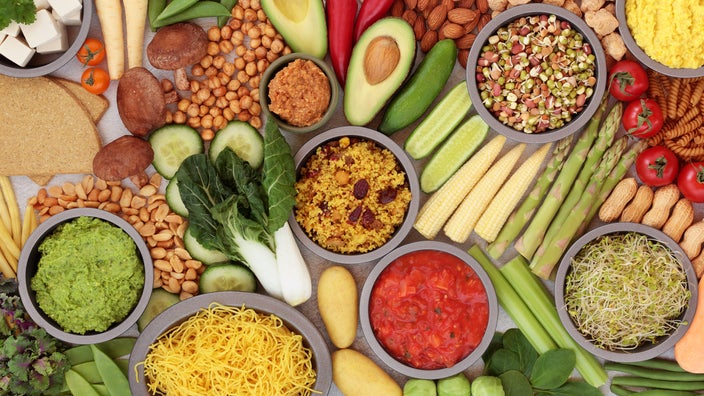
Are High-Oxalate Foods Bad for You?
Key takeaways:
Oxalate is a substance that’s in many different foods, and it’s harmless for most people. But if you’re trying to prevent certain types of kidney stones, it’s best to eat a low-oxalate diet.
Foods that are high in oxalate include spinach, rhubarb, rice bran, buckwheat, almonds, and miso. Many other foods also have oxalate, but you can eat them in moderation.
If you’re prone to calcium oxalate kidney stones, make sure to eat enough calcium in your diet. This helps decrease the amount of oxalate your body absorbs from food.
Table of contents

For people who have a tendency to form certain types of kidney stones — ones that form from a combination of calcium and oxalate — eating a diet high in oxalate can increase the risk of more kidney stones.
But what are oxalates? And why do they cause kidney stones in some people? We’ll dive into that — and what foods and beverages are high in oxalates.
What are oxalates?
Oxalic acid, or oxalate, is a compound that’s in many different foods — like vegetables, beans, and grains. For most people, oxalate is completely harmless, and they simply pee it out in their urine. Other people, however, have difficulty getting rid of excess oxalate. Instead of peeing it out, it builds up and forms crystals that stick together and cause kidney stones.
Reducing the amount of oxalate-containing foods in the diet is commonly recommended for people who are prone to the development of calcium oxalate stones.
List of foods high in oxalates
Many foods have oxalate. If you’re prone to calcium oxalate kidney stones and are trying to follow a low-oxalate diet, this list of foods can be overwhelming. So let’s review some numbers that will help you know where to start.
A typical diet has 200 mg to 300 mg of oxalate per day. A low-oxalate diet should have fewer than 100 mg of oxalate per day — and 50 mg per day is ideal. So it helps to have a general idea of how much oxalate is in a serving of different foods.
A good place to start is to:
Avoid the foods highest in oxalate.
Limit foods that are high in oxalate. Try not to have more than one serving of these per day.
Be aware of the foods moderately high in oxalate, and try not to eat multiple servings of these per day.
Save over 40% on Qsymia with GoodRx
Discover the once daily Qsymia for weight management. Qsymia is for adults and children 12-17 in combination with a healthy diet and regular exercise.

A lot of the foods below can still be part of a balanced and nutritious diet, so it helps to remember that you don’t need to completely avoid foods high in oxalate. Instead, be mindful when eating these foods so that you don’t accidentally load up on oxalate. The goal is to limit oxalate rather than eliminate it completely.
Foods highest in oxalate
Foods highest in oxalate (over 100 mg per serving) include:
Food | Oxalate content per serving |
|---|---|
Beets, boiled (½ cup) | 574 mg |
Rhubarb (½ cup) | 541 mg |
Snap beans, raw (1 cup) | 360 mg |
Buckwheat flour (1 cup) | 323 mg |
Brussels sprouts, raw (1 cup) | 317 mg |
Carrots, raw (½ cup, sliced) | 305 mg |
Wheat germ (1 cup) | 304 mg |
Spinach, raw (1 cup) | 291 mg |
Soy yogurt (1 cup) | 257 mg |
Rice bran (1 cup) | 281 mg |
Tofu (3 oz) | 231 mg |
Celery, raw (1 cup, chopped) | 192 mg |
Broccoli, raw (1 cup, chopped) | 167 mg |
Cauliflower, raw (1 cup, chopped) | 160 mg |
Soy flour (1 cup) | 154 mg |
Buckwheat groats, roasted (1 cup) | 132.6 mg |
Soy protein isolate (1 oz) | 131 mg |
Almonds (1 oz) | 130 mg |
Watercress, raw (1 cup) | 105 mg |
Foods high in oxalate
Foods high in oxalate (between 40 mg and 100 mg per serving) include:
Food | Oxalate content per serving |
|---|---|
Wheat berries (1 cup, cooked) | 98 mg |
Navy beans, canned (½ cup) | 96 mg |
Baked potato (1, with skin) | 92 mg |
Bulgur, cooked (1 cup) | 86 mg |
Dark chocolate (1.5 oz) | 68 mg |
Cocoa powder (4 tbsp) | 67 mg |
Hot chocolate (1 cup) | 65 mg |
Cornmeal (1 cup) | 64 mg |
Cashews (1 oz) | 64 mg |
Hazelnuts (1 oz) | 62 mg |
Refried beans (½ cup) | 60 mg |
Baked beans (½ cup) | 58 mg |
Quinoa, cooked (1 cup) | 54 mg |
Sweet potato (½ cup) | 54 mg |
French fries (6 oz) | 49 mg |
Corn grits, cooked (1 cup) | 45 mg |
40% bran flakes (1 cup) | 43 mg |
Miso (1 cup) | 40 mg |
Foods moderately high in oxalate
Foods moderately high in oxalate (10 mg to 40 mg per serving) include:
Other nuts, like walnuts, peanuts, pistachios, and pecans, and nut butter
Tahini and sesame seeds
All-purpose flour and bread products, like bagels
Oranges and grapefruits
Dried fruit, like pineapples, dates, and figs
Brown rice
Soy milk, and veggie burgers
Beans, like fava beans and red kidney beans
Avocados
Olives
Kiwis
Turnips and parsnips
Collard greens
Pumpkin seeds and sunflower seeds
Tomato sauce
Tea
Drinks that are high in oxalates
There are a few beverages that are high in oxalates that should be limited. These include:
Hot chocolate
Nut milk (almond milk, soy milk, cashew milk, and hazelnut milk)
Coffee drinks that contain cocoa or plant-based milk
Smoothies containing spinach, plant-based milks, avocados, or raspberries
List of low-oxalate foods
There are still plenty of nutritious foods that are low in oxalate. The following list is just a sampling of foods that have fewer than 2 mg of oxalate:
Bananas
Apples
Melons
Mushrooms
Onions
Peas
White potatoes
Bread
Noodles
The best drinks for kidney stones: Research suggests that beverages — like orange juice and coffee — may help prevent kidney stones. Get the full list here.
Do you need a CT scan every time you have a kidney stone? No, even though many healthcare professionals recommend them. Learn how to avoid unnecessary testing.
Eating for kidney health: Beyond kidney stone prevention, these foods and drinks can help keep your kidneys running smoothly.
For people who form calcium oxalate kidney stones, eating enough calcium in the diet may also help. If you eat a food high in oxalate, try to pair it with a food high in calcium (like dairy products). This is because the calcium binds to the oxalate and prevents your body from absorbing it.
How do high-oxalate foods contribute to kidney stones?
For most people, oxalate has no effect on the body. The body just excretes it in the urine, and it’s harmless. But in some people, oxalate in the urine combines with calcium to form kidney stones.
Calcium oxalate stones are the most common type of kidney stones. These stones form when calcium and oxalate combine in the urinary tract and solidify into a pebble-like substance. This is why it’s helpful to avoid too much oxalate, but also to make sure you get enough calcium in your diet. The calcium will help bind up whatever oxalate is in your system.
Read more like this
Explore these related articles, suggested for readers like you.
Keep in mind that there are other types of kidney stones that oxalate doesn’t affect. A healthcare professional can check the composition of your kidney stones to figure out exactly which type you have. You’ll need to strain your urine while passing the stones, so you can then bring them in for testing.
Frequently asked questions
The main benefit of a low-oxalate diet is to prevent calcium oxalate kidney stones. There’s no evidence that a low-oxalate diet helps with other health conditions. Some online sources claim this type of diet can help with conditions like autism or autoimmune disorders. But there’s no scientific evidence to back up these claims.
Increasing the amount of water you drink may help decrease the recurrence of kidney stones. Increased fluid intake helps to dilute your urine. This can flush certain elements out of your body, making it more difficult for kidney stones to form.
Too much oxalate doesn’t cause any symptoms — unless it leads to a kidney stone. When a kidney stone forms and blocks the urinary tract, symptoms include:
Waves of sharp pain in the back and side
Pain accompanied by nausea, and possibly vomiting
Blood in the urine
A sense of urgency to urinate
Dairy products contain calcium, which binds to oxalates and helps decrease kidney stone formation. There’s some evidence that citrus products like orange juice appear to reduce the formation of calcium oxalate kidney stones by altering the pH of our urine.
Yes, boiling vegetables reduces their oxalate content. Some of the oxalates in vegetables are water soluble, so they escape into the water when heated. Steaming vegetables isn’t as effective — but a small amount is lost that way as well.
The bottom line
The most common type of kidney stones are made of calcium oxalate. And eating a diet low in oxalate can help prevent them. This is important for people who have a history of calcium oxalate kidney stones. People who have no history of kidney stones don’t need to eat a diet low in oxalate. And it’s not possible or healthy to completely eliminate oxalate from your diet. But if you’re prone to kidney stones, it can help to eat high-oxalate foods in moderation and pair them with foods high in calcium.
Why trust our experts?


References
Barghouthy, Y., et al. (2021). Role of citrus fruit juices in prevention of kidney stone disease (KSD): A narrative review. Nutrients.
Chai, W., et al. (2005). Effect of different cooking methods on vegetable oxalate content. Journal of Agricultural and Food Chemistry.
Charrier, M. J., et al. (2002). Oxalate content and calcium binding capacity of tea and herbal teas. Asia Pacific Journal of Clinical Nutrition.
Harris, J. (2015). How to eat a low oxalate diet. The University of Chicago Kidney Stone Program.
National Kidney Foundation. (2024). Calcium oxalate stones.
Nephrology Associates. (n.d.). Low oxalate diet.
Prezioso, D., et al. (2017). Dietary treatment of urinary risk factors for renal stone formation: A review of CLU Working Group. Archivio Italiano di Urologia e Andrologia.





























